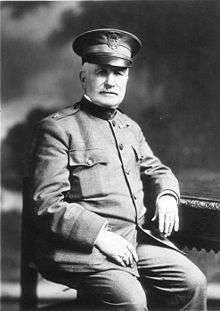William Williams Keen
| William Williams Keen Jr. | |
|---|---|
 Keen in December 1918 | |
| Born |
January 19, 1837 Philadelphia, Pennsylvania, U.S. |
| Died |
June 7, 1932 (aged 95) Philadelphia, Pennsylvania, U.S. |
| Children | Dora Keen |
| Relatives | Walter Jackson Freeman II (grandson) |
William Williams Keen Jr. (January 19, 1837 – June 7, 1932) was an American doctor who was the first brain surgeon in the United States. He also saw Franklin D. Roosevelt when his paralytic illness struck, and worked closely with six American presidents.
Biography
Keen was born in Philadelphia, Pennsylvania on January 19, 1837, the son of William Williams Keen Sr. (1797–1882) and Susan Budd. He attended Philadelphia's Central High School.[1] He studied at Brown University, where he graduated in 1859. He graduated in medicine from Jefferson Medical College in 1862.[2] During the American Civil War, he worked for the U.S. Army as a surgeon. After the war, he spent two years studying in Paris and Berlin.[3]
Keen started lecturing surgical pathology in Philadelphia. He was president of the Philadelphia School of Anatomy from 1875 to 1889. He became known in the medical community around the world for inventing several new procedures in brain surgery, including drainage of the cerebral ventricles and removals of large brain tumors. In 1888 Keen also performed one of the first successful removals of a brain tumor.[1]
Keen was the leader of a team of five that performed a secret surgical operation to remove a cancerous jaw tumor on Grover Cleveland in 1893 aboard Elias Cornelius Benedict's yacht Utowana. Keen and four assisting doctors made their way to the yacht by boat from separate points in New York with Cleveland and Bryant boarding in the evening for the night aboard before sailing the next morning. With clam weather the surgery was done shortly after noon as the ship transited Long Island Sound with the removal of the tumor, five teeth, as well as much of the upper left palate and jawbone. On 5 July Cleveland arrived at Gray Gables to recuperate and was fishing in Buzzards Bay by the end of July.[4]
Keen married in 1867 to Emma Corinna Borden. They had four children: Corinne, Florence, Dora, and Margaret. He died in Philadelphia on June 7, 1932, at the age of 95.[5][6] Keen's grandson, Walter Jackson Freeman II, became a doctor who specialized in lobotomies.
Honors and recognition
He received honorary degrees from Jefferson Medical College and Brown, Northwestern, Toronto, Edinburgh, Yale, St. Andrews, Greifswald, and Upsala unpresident of the American Surgical Association (1898), the American Medical Association (1900), the Congress of American Physicians and Surgeons (1903), and the American Philosophical Society (after 1907).[7]
In 1914, at a meeting of the International Surgical Association, he was elected president for the meeting of 1917. After 1894, he was foreign corresponding member of the Société de Chirurgie de Paris, the Société Belge de Chirurgie, and the Clinical Society of London; honorary fellow of the Royal College of Surgeons of England, the Royal College of Surgeons of Edinburgh, the German Society of Surgery, the Palermo Surgical Society, and the Berliner Medizinische Gesellschaft and associate fellow of the American Academy of Arts and Sciences.[8]
Procedures and signs
- Keen's operation, an omphalectomy
- Keen's sign, increased diameter of the leg at the malleoli in Pott's fracture of the fibula.
Works
.png)
He published:
- Clinical Charts of the Human Body (1870)
- Early History of Practical Anatomy (1875)
- Surgical Complications and Sequels of Typhoid Fever (1898)
- Addresses and Other Papers (1905)
- Animal Experimentation and Medical Progress (1914)
- an edition of Heath's Practical Anatomy (1870)
- the New American from the Eleventh English Edition of Gray's Anatomy (Sept 1887) [9]
- the New American from the Thirteenth English Edition of Gray's Anatomy (Sept 1893) [9]
- the American Text-Book of Surgery (1899, 1903)
- Keen's System of Surgery (1905–13)
- I believe in God and in evolution (1922)
- Everlasting life, A creed and a speculation (1924)
Co-authored:
- Gunshot Wounds, and Other Injuries of Nerves, together with Silas Weir Mitchell, George Read Morehouse (1864)
References
- 1 2 "William Williams Keen American Brain Surgeon". www.britannica.com. Retrieved 24 October 2017.
- ↑ McCallum, Jack Edward (2008). Military Medicine: From Ancient Times to the 21st Century. Santa Barbara, CA: ABC-CLIO, Inc. p. 177. ISBN 978-1-85109-693-0. Retrieved 24 October 2017.
- ↑ Keen, William Williams (2016). Surgical Reminiscences of the Civil War. Big Byte Books. Retrieved 24 October 2017.
- ↑ Algeo, Matthew. "A President, A Yacht, And A Secret Operation". BoatUS. No. October/November 2011. Retrieved 19 September 2018.
- ↑ "Dr. W.W. Keen Dies. Famous Surgeon. Assistant in Operation in 1893 on President Cleveland for Removal of Sarcoma. Had Served in Three Wars. Vigorous Exponent of Theory of Evolution and of Vivisection. Long Professor at Jefferson". New York Times. June 8, 1932. Retrieved 2013-12-16.
- ↑ "Dr. Keen, Famous Surgeon, Is Dead". Associated Press in the Milwaukee Sentinel. June 8, 1932. Retrieved 2010-07-31.
Dr. William Williams Keen, who won world fame by his skill with the surgeon's knife, died at his home here Tuesday night from the ...
- ↑ New International Encyclopedia
- ↑ "Keen, William Williams". www.brown.edu. Retrieved 25 October 2017.
- 1 2 Carmine D. Clemente, ed. (1985). Gray’s Anatomy (30th ed.). Philadelphia: Lea & Febiger. ISBN 0-8121-0644-X. pp.vi-ix
External links
| Wikisource has original works written by or about: William Williams Keen |
| Wikimedia Commons has media related to William Williams Keen. |
- Biography and pictures
- Gray's Anatomy: The Jefferson Years Scroll down page to find reference to W.W. Keen.
- William Williams Keen at Find a Grave
- William W. Keen Papers at John Hay Library, Brown University.